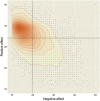HowNutsAreTheDutch (HoeGekIsNL): A crowdsourcing study of mental symptoms and strengths
- PMID: 26395198
- PMCID: PMC6877205
- DOI: 10.1002/mpr.1495
HowNutsAreTheDutch (HoeGekIsNL): A crowdsourcing study of mental symptoms and strengths
Abstract
HowNutsAreTheDutch (Dutch: HoeGekIsNL) is a national crowdsourcing study designed to investigate multiple continuous mental health dimensions in a sample from the general population (n = 12,503). Its main objective is to create an empirically based representation of mental strengths and vulnerabilities, accounting for (i) dimensionality and heterogeneity, (ii) interactivity between symptoms and strengths, and (iii) intra-individual variability. To do so, HowNutsAreTheDutch (HND) makes use of an internet platform that allows participants to (a) compare themselves to other participants via cross-sectional questionnaires and (b) to monitor themselves three times a day for 30 days with an intensive longitudinal diary study via their smartphone. These data enable for personalized feedback to participants, a study of profiles of mental strengths and weaknesses, and zooming into the fine-grained level of dynamic relationships between variables over time. Measuring both psychiatric symptomatology and mental strengths and resources enables for an investigation of their interactions, which may underlie the wide variety of observed mental states in the population. The present paper describes the applied methods and technology, and presents the sample characteristics. Copyright © 2015 John Wiley & Sons, Ltd.
Keywords: crowdsourcing; ecological momentary assessment; longitudinal; mental strengths and resources; mental symptoms.
Copyright © 2015 John Wiley & Sons, Ltd.
Figures





References
-
- Abdel‐Khalek A. (2006) Measuring happiness with a single‐item scale. Social Behavior & Personality: An International Journal, 34(2), 139–149.
-
- Arrindell W.A., Ettema J.H.M. (1986) SCL‐90. Handleiding bij een multidimensionale psyhopathologie indicator, Lisse: Swets & Zeitlinger.
-
- Barge‐Schaapveld D.Q.C.M., Nicolson N.A., Berkhof J., deVries M.W. (1999) Quality of life in depression: daily life determinants and variability. Psychiatry Research, 88(3), 173–189. - PubMed
MeSH terms
LinkOut - more resources
Full Text Sources
Other Literature Sources
Medical

